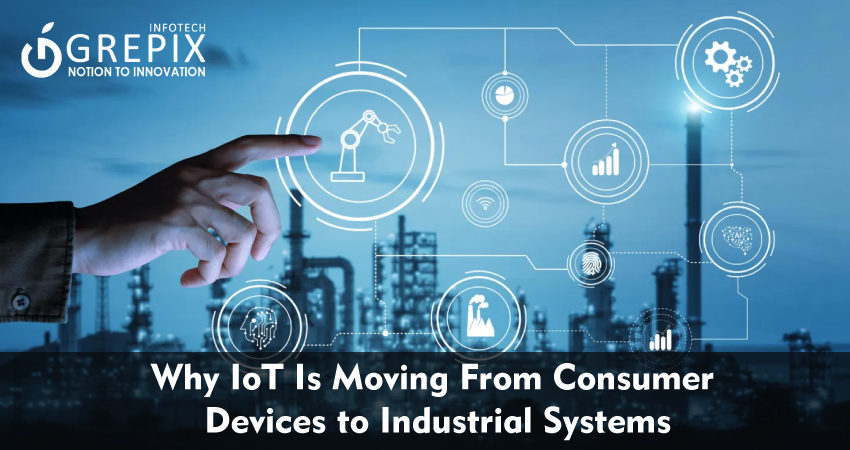Why IoT Is Moving From Consumer Devices to Industrial Systems
Let’s face it. When most people think about IoT, they picture smart thermostats, connected fridges, or fitness trackers. But the real magic of the Internet of Things is happening far from living rooms. Welcome to the world of Industrial IoT (IoT), where factories, power plants, and logistics hubs are undergoing a quiet but powerful revolution.
At the heart of this shift is a need for real time telemetry and automated processes. It’s no longer just about convenience. In industrial settings, IoT is about precision, safety, uptime, and cost savings. Think sensors that detect overheating in machines before failure, or networks that instantly adjust supply chains in response to demand spikes.
In this blog, we’ll explore why IoT is rapidly shifting from consumer toys to industrial titans. We’ll break down major IIoT use cases, the rise of edge computing, and how security concerns are being addressed head-on.
IoT is no longer just for smart homes and fitness gadgets. The real revolution is happening in industrial sectors through Industrial IoT (IoT). This blog dives deep into how industries like manufacturing, energy, logistics, and agriculture are harnessing IoT to drive real-time telemetry and automation. With the help of edge computing, businesses are processing data closer to the source, reducing latency and improving safety. At the same time, security measures are evolving with encryption, authentication, and AI-powered threat detection. While challenges like interoperability and skill shortages remain, the shift to IIoT is accelerating due to technology maturity and global pressures for efficiency and sustainability. The future of industrial IoT holds the promise of intelligent automation, digital twins, and more resilient operations.
Industrial IoT Use Cases: Where the Real Action Is
1. Predictive Maintenance in Manufacturing
Imagine a factory in Germany making car parts. With IoT sensors attached to each machine, they can monitor temperature, vibration, and wear in real time. If a motor starts showing abnormal readings, the system can predict failure before it happens, triggering maintenance just in time.
This approach reduces unplanned downtime, improves safety, and saves millions. Companies like Siemens and GE are pioneers in this predictive maintenance game.
2. Smart Grids and Energy Management
In the energy sector, smart grids powered by IoT devices are improving how we generate, distribute, and consume electricity. Utilities in countries like India and Brazil are using industrial IoT solutions to remotely manage power loads, detect faults, and even prevent blackouts.
IoT use cases in this area include:
- Monitoring transformer health
- Balancing loads during peak hours
- Reducing energy waste through real-time analytics
3. Logistics and Fleet Tracking
Let’s talk trucks. A logistics company in the US can now track every vehicle in its fleet using GPS and onboard IoT sensors. These sensors give data on:
- Fuel consumption
- Route efficiency
- Driver behavior
- Vehicle health
It’s not just about location anymore. It's about performance, safety, and cost-efficiency. Companies like DHL and FedEx have fully embraced industrial IoT for better fleet management.
4. Agriculture and Smart Farming
Farming has gone digital. From the rice fields in Vietnam to vineyards in France, farmers are installing IoT sensors to monitor soil moisture, weather, and crop health.
Use cases include:
- Automated irrigation systems
- Livestock tracking with wearables
- Drones with sensors for crop scanning
IIoT is helping farmers increase yields, reduce waste, and operate more sustainably.
5. Oil, Gas, and Mining
These industries are high-risk, high-reward, and every second counts. IIoT helps by:
- Monitoring pipeline pressure to detect leaks
- Tracking equipment usage underground
- Ensuring worker safety with wearables
Companies like Schlumberger and Halliburton use industrial IoT to reduce operational hazards and improve efficiency.
The Rise of Edge Computing
So, why is edge computing such a big deal in IIoT?
Industrial environments generate a ton of data, and sending all that to the cloud can cause delays. In scenarios where milliseconds matter, you need decisions made on the spot.
What Is Edge Computing?
Edge computing processes data locally, near the source, instead of relying on a central cloud server. This means:
- Lower latency
- Less bandwidth consumption
- More reliable operations during connectivity issues
Real-World Example: Smart Factories
A textile plant in Bangladesh using IoT for quality control can’t afford a lag when detecting defects in fabrics. Edge devices process visual data in real time to catch errors immediately. No internet delay, no costly mistakes.
Edge computing and industrial IoT go hand in hand, especially when safety and timing are non-negotiable.
Tackling Security Concerns Head-On
Let’s be honest. More devices mean more entry points for hackers.
Key Security Challenges
- Unauthorized access to critical systems
- Data interception during transmission
- Device spoofing or hijacking
These risks aren’t just theoretical. In 2010, the Stuxnet worm took down centrifuges in Iran using a form of IoT vulnerability.
How Industry Is Responding
The good news is that industrial IoT developers are stepping up. Security strategies include:
- Device authentication: Ensuring only trusted devices can connect
- End-to-end encryption: Protecting data from source to cloud
- Zero Trust Architecture: Verifying every access attempt
Organizations like ISA and NIST are publishing best practices for IIoT security standards.
Role of AI in IoT Security
AI is increasingly used to detect anomalies in real-time. For example, if a machine suddenly starts behaving oddly or a device attempts to connect from an unusual location, the system can flag it instantly.
Also Read: "The Rise of IoT in Taxi App Development: Enhancing Safety and Efficiency"
Why the Shift Now?
Maturity of Technology
The sensors are cheaper, the connectivity is faster (hello, 5G), and the cloud platforms are more robust. In short, it’s the perfect storm.
Global Supply Chain Pressures
COVID-19 and global disruptions have made resilience a top priority. Industries are turning to IIoT for visibility and agility.
Sustainability Demands
Governments and consumers alike are pushing for greener operations. IIoT helps optimize energy use and reduce emissions.
Real Talk: Challenges to Watch Out For
Not everything is smooth sailing.
1. Interoperability Issues
Devices from different vendors don’t always play nice. Standardization is a work in progress.
2. Skill Gaps
There’s a shortage of professionals who understand both OT (Operational Tech) and IT. Training is crucial.
3. Cost of Implementation
Initial investment in industrial IoT can be high. But over time, the ROI is compelling.
The Future of Industrial IoT
IIoT is just getting started. As tech evolves, expect to see:
- AI-driven automation: Smarter, self-optimizing machines
- Digital twins: Real time simulations of entire systems
- Blockchain: For tamper proof supply chain records
We’re looking at a world where machines don’t just operate they think, adapt, and improve.
Conclusion
As the world shifts gears from consumer convenience to industrial intelligence, Grepix Infotech is at the forefront of this transformation. With a strong legacy in mobile app development, Grepix has evolved into a trusted technology partner for businesses looking to harness the power of Industrial IoT.
From smart factory control panels to real-time fleet tracking apps, Grepix builds intuitive, scalable, and secure solutions that help industries move faster, operate smarter, and reduce downtime. Their deep understanding of both mobile and enterprise-grade software makes them uniquely positioned to bridge the gap between OT (Operational Technology) and IT (Information Technology).
Whether it's developing IoT dashboards, integrating edge computing, or building predictive maintenance systems, Grepix Infotech ensures every solution is tailored to business goals and user needs. The company combines innovation with industry best practices to deliver robust apps that support real-time telemetry, automation, and analytics.
As industrial sectors around the world embrace digital transformation, Grepix continues to lead the charge helping clients unlock the true potential of connected systems. If you're planning your next step in digital operations or industrial IoT, Grepix Infotech is the ideal partner to turn vision into reality.
FAQs
1. What is Industrial IoT (IoT)?
Industrial IoT refers to the use of connected devices and sensors in industrial environments like manufacturing, energy, and logistics.
2. How does edge computing support IoT?
Edge computing processes data closer to the source, reducing latency and enabling faster decision-making in industrial settings.
3. Are IoT systems secure?
Yes, with encryption, authentication, and AI-based monitoring, IoT systems are becoming increasingly secure against cyber threats.
4. What industries benefit most from IoT?
Industries like manufacturing, energy, logistics, agriculture, and mining gain significant value from IoT adoption.
5. What are some common IoT use cases in industries?
Predictive maintenance, real-time tracking, energy monitoring, and process automation are some of the top use cases.
Launch your vision with our mobile app development company, where innovation meets excellence to create cutting edge mobile solutions."







